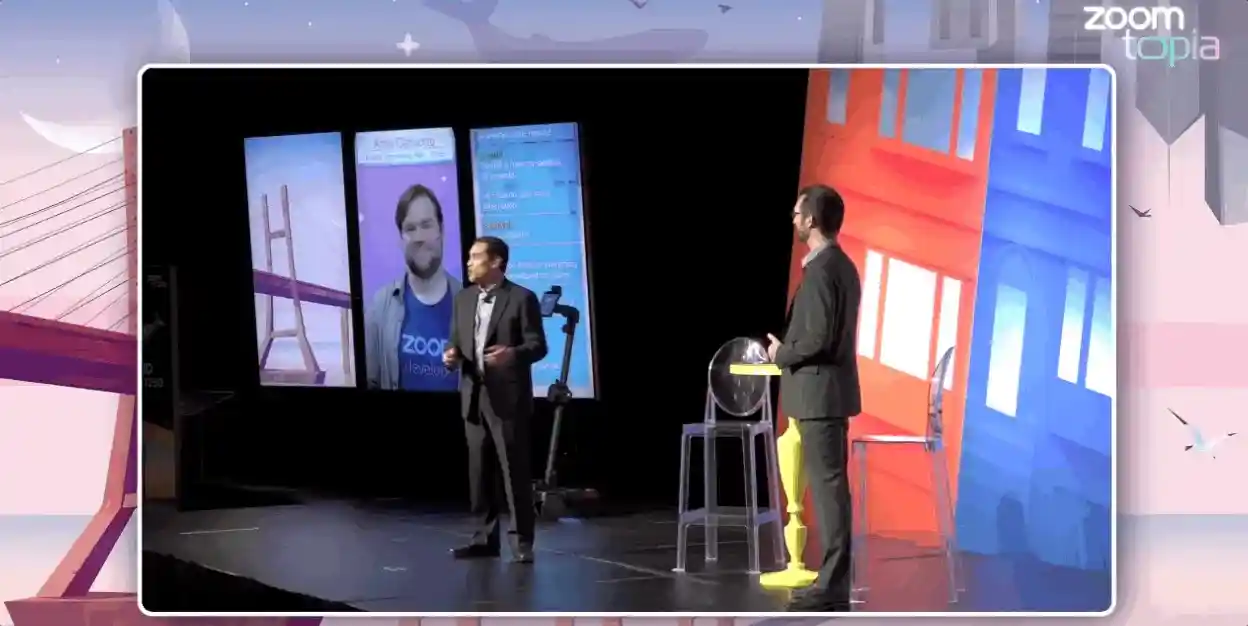
Making work smarter, faster, and more human with practical AI implementation
Following these principles helps IT leaders make informed decisions that align AI adoption with business priorities.
Updated on December 01, 2022
Published on December 01, 2022


“Think bigger.” That’s our motto, and it permeates everything we do — from large-scale product announcements to exploring new use cases across verticals to the genesis of our platform.
Zoom was started by our founder and CEO, Eric S. Yuan, as an app based on love. He wanted to connect with his then-long-distance girlfriend (now wife!), and he wanted a simple, reliable way to build that bond.
Since then, Zoom has evolved into a comprehensive unified communications platform — video, voice, contact center, developer tools, and more — that isn’t just for use in a traditional office setting. It can be used in retail stores, on manufacturing floors, in classrooms, in the field, you name it.
That’s exactly what these vertical Zoomtopia sessions explored — all the ways we can think bigger and use the Zoom platform to accomplish a lot more.
At Zoom, we’re all about the art of the possible — and that’s what our emerging verticals keynote explored in depth. What are the meaningful benefits we can create with this technology? How do we think bigger to improve the employee experience, elevate customer engagement, and accelerate operational transformation?
I answered those questions with a simple equation: platform + value = use cases that drive meaningful benefits.
That equation informs this next wave of vertical strategy. We’re focused on creating value through the strategic application of our technology. That equation is going to be the key to using Zoom to help enhance retail customer services, drive supply chain efficiencies for logistics companies, reduce time to market for manufacturers, increase on-campus safety for students, and more.
“But how do you break barriers so you can look at new options?” posed our CTO, Brendan Ittleson, who joined the keynote to speak to the impact of our developer platform on these verticals. “This platform can help make these ideas a reality, as it lets you bring the Zoom tech you need into an environment and marry it with your product and vision. That way you can focus on the vision, and not have to worry about the communications infrastructure,” added Brendan.
Here are a few ways we’re already seeing how Zoom can help turn our customers’ dreams into reality:
I was joined by Irwin Lazar, president and principal analyst at Metrigy, and Zeus Kerravala, founder and principal analyst at ZK Research, for our industry analyst session to discuss how you can mix elements of our platform with partner capabilities to unearth new use cases and extend traditional benefits.
Irwin and Zeus chatted about how the UCaaS industry has evolved to get us to this point, speaking to the role this technology can play in different scenarios and how it can create impactful outcomes.
“It’s not just a set of features, it’s a set of capabilities that I can build into a client, apps, or devices so that I can work or act however I want,” Zeus said.
Our own Charlie Thomlinson, retail industry sales lead in Australia/New Zealand, and Jared Allen, technical sales architect, were joined by Shane Lenton, CIO at Cue Clothing, to reflect on the current retail trends we’re seeing. What started as a pivot to video in the face of COVID-19 has now resulted in a seamless and comprehensive virtual buying experience that’s remaining a post-pandemic preference — an approach that Cue Clothing adopted even before COVID.
Shane explained the origin story of Cue Clothing’s video commerce initiative: a shopping trip with his wife. When she wanted to go into the city to refresh her wardrobe, he thought, “there’s got to be a better way than driving into the city, finding a parking spot, what have you.” From there, he set out to turn this idea into a reality, which led him to Zoom. Using our platform to connect team members and customers virtually and augmenting those interactions with the Brauz booking engine for secure transactions, Shane’s adoption of an end-to-end platform helped Cue Clothing remain resilient and profitable during lockdown and beyond.
For our manufacturing session, I hopped on with Rama Oruganti, chief product officer at RealWear, and Jay Mcardle, senior director of product management at HP-Poly, to talk through how video-enabled hardware devices can elevate manufacturing operations, improve quality and safety, reduce time-to-market, and more.
Both spoke to how video-enabled technology has served as a linchpin for manufacturing organizations. As Rama noted, “[It’s important to] retain and share knowledge when the global workforce is fragmented but needs real-time interactions, and we're addressing that challenge through partners like Zoom. Minimize travel and maximize real-time knowledge-sharing.”
Jay added, “We’ve seen a number of manufacturing transformations. People come to us and say ‘I need to be able to show my customers what their showrooms are going to look like, so how do I do that virtually and in an immersive experience?’ We provide the technology that helps enable that.”
Whether you’re innovating for a retail or manufacturing organization, or trying to provide new services to students or your community, it’s important to meet your people where they are. These sessions highlighted what’s possible when you identify the communication channels that your people prefer and provide them with opportunities for genuine connection. From there, additional benefits such as customer loyalty, employee engagement, and operational efficiency come naturally.
Check out all the emerging vertical Zoomtopia 2022 sessions in our on-demand library.